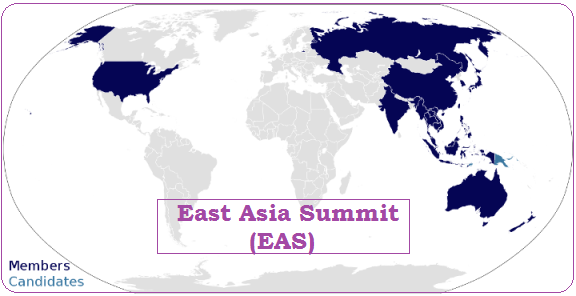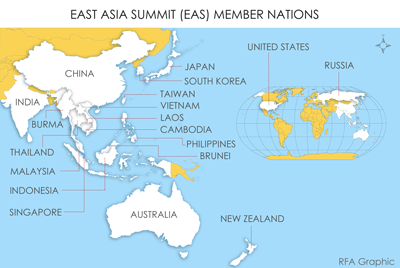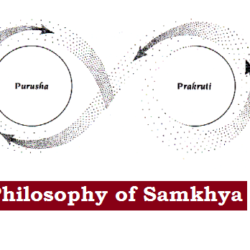
The East Asia Summit (EAS) established in 2005 is a forum of 18 regional leaders for strategic dialogue and cooperation on the key political, security, and economic challenges facing the Indo-Pacific region.
EAS is an initiative of ASEAN and is based on the premise of the centrality of ASEAN, it can only be chaired by an ASEAN member.
East Asia Summit
| Established | 2005 |
| 1st Summit | Dec 2005, Kuala Lumpur (Malaysia) |
| 6th Summit | Nov 2011, Bali (Indonesia) |
| 13th Summit | Nov 2018, Singapore |
| 14th Summit | TBD, Thailand |
| Table of Contents: |
| Areas of Cooperation Membership Significance Challenges Significance for India India’s Involvement |
Areas of Cooperation
- Environment and Energy,
- Education,
- Finance,
- Global Health Issues and Pandemic Diseases,
- Natural Disaster Management, and
- ASEAN Connectivity
- Maritime Cooperation (Included in 12th EAS in November 2017 in Manila)
Membership

The membership of EAS consists of 10 ASEAN Member States (i.e. Brunei Darussalam, Cambodia, Indonesia, Lao PDR, Malaysia, Myanmar, Singapore, Thailand, the Philippines and Vietnam), 6 members(ASEAN+6)– Australia, China, India, Japan, New Zealand, Republic of Korea. At the 6th Annual Summit 2011 at Bali (Indonesia) Russian Federation and the USA joined EAS.
Significance
- EAS representing nearly 50% of the world’s population and over 20% of global trade, is a mega gathering and is a testimony to the rise of Asia.
- EAS is a region of strong and fast growing economies. It is considered the third pole of world economy after the US and Europe. Its four major economic players namely Japan, China, India and South Korea are among the twelve largest ranking global economies.
- Financial and monetary cooperation between ASEAN+6 (or EAS countries leaving USA and Russia) could be an area of fruitful cooperation in view of the fact that their combined foreign exchange reserves exceed USD 3 trillion.
Challenges
- Nation rivalry: China-Japan rift casts a big shadow over the EAS and also potential rivalry between China-India, as China sees India as competitor not just for investments and markets but also for political and security reasons.
- Institutionalization and institution building issues: The position adopted at the summit clearly makes EAS an ASEAN driven organization.
- Wide agenda: It may not be possible to work effectively on all the parts of the agenda. There is a general understanding that the economic agenda will be pursued more vigorously as compared to cultural and political/security agenda.
- Relationship with other regional organizations: The boundary between ASEAN and EAS is hazy and even confusing.
Significance for India
Economic Cooperation:
- India’s membership to the EAS is recognition of its fast growing economic and political clout.
- Deeper integration with the EAS members, therefore, helped sustain India’s external sector as an engine of growth even during 2008 economic crisis.
- India’s strength lies in service sector and information-technology and Japan has a sound capital base. Thus there are complementarities in trade and production structures of the EAS members.
- There are prospects of the Indian private sector being involved in defence production and supplies which will greatly improve India’s defence diplomacy in the region. India has also conducted naval exercises with almost all the EAS members and is actively participating in counter-terrorism efforts under the ASEAN and BIMSTEC frameworks of sub-regional 40 groupings.
Infrastructure Development:
- India is also keen on monetary integration of the EAS region and cooperation in the energy sector. The East Asian countries are already involved in India’s infrastructural sector and they can take further advantage of the opportunity available.
- For implementation of connectivity projects, such as the India-Myanmar-Thailand trilateral highway, and building new trade and transport linkages with all the EAS member states, the summit gains significance.
Political Diplomacy:
- For India it acts as an alternative to the APEC in which India doesn’t enjoy the membership.
- In order to build multi-faceted relations with ASEAN and other multilateral nations and strengthen bilateral relations India has emphasized upon its Act East Policy for which EAS will prove crucial.
Global Issues:
- China’s assertiveness in the South China Sea and the nature of its growing investments has led the ASEAN countries to view India as a potential power that could balance a rising China.
- Also, South China Sea is a busy waterway through which half of India’s trade passes, hence for freedom of passage in the international waters, EAS becomes crucial.
Cultural Connection:
- India’s deep cultural and civilization links with the EAS countries are widely known. India can play a major role in cultural and people to people cooperation with the region, which can reinforce the economic momentum for community building.
India’s Involvement
1. Education:
- At the 4th East Asia Summit (EAS), held in Thailand on 24-25 October 2009, the EAS Leaders endorsed the proposal for the revival of Nalanda University.
- The University envisages seven schools located at its campus in Rajgir.
- Ministry of External Affairs has offered 6 scholarships to students from Cambodia, Myanmar, Lao PDR and Vietnam to pursue higher studies at Nalanda University
2. Natural Disaster Management
- Launch of Virtual Knowledge Portal (VKP), a web based tool to share knowledge and best practices related to natural disaster risk assessment, mitigation and response among EAS countries.
- It is hosted by Natural Institute of Disaster Management, New Delhi.
3. Finance:
- At the 7th EAS in November 2012, the Leaders of 16 EAS participating countries launched the Regional Comprehensive Economic Partnership (RCEP)

 Home
Home Syllabus
Syllabus Contact Us
Contact Us




